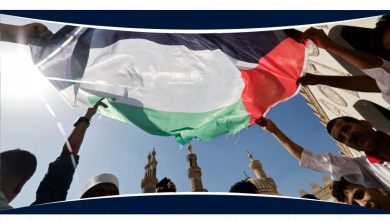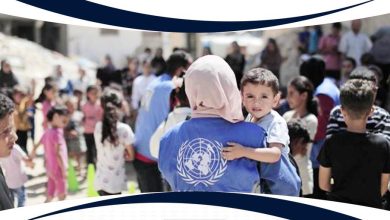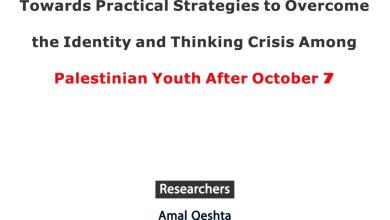Gaza: What Lies Ahead
 Following the coup in the Gaza Strip in June 2007, many surprises took place on both sides of the crisis. While Hamas, which due its earlier internal discipline was able to deal more efficiently with challenges, faced making a different Hamas after the coup than Hamas before the coup, Fateh and the PA responded negatively, failing to solve their internal problems and deepening their internal crisis. Little effort was exerted by Fateh to build strategies to face the new challenges and realities.
Following the coup in the Gaza Strip in June 2007, many surprises took place on both sides of the crisis. While Hamas, which due its earlier internal discipline was able to deal more efficiently with challenges, faced making a different Hamas after the coup than Hamas before the coup, Fateh and the PA responded negatively, failing to solve their internal problems and deepening their internal crisis. Little effort was exerted by Fateh to build strategies to face the new challenges and realities.
Hamas challenges after the coup:
Hamas after the coup is different than Hamas before the coup
Hamas was able to a large extent to deal with the new challenges as a movement in power for the first time. Those challenges included:
Internal security: Kidnapping and internal clashes were a dominant phenomenon in Gaza and were frequently used by Hamas to reach power. Nevertheless, after the coup Hamas was able to impose order, disarm the families, clean the roads and ease the movement of people in the whole of the Gaza Strip. The release of Alan Johnston was a good example of Hamas’s ability to offer what was missing in the past; namely, internal security. Not a single kidnapping has taken place since Hamas took over.
b.
Resistance and missile launching: At first, Hamas was ready to control the other movements and parties (like Islamic Jihad and al-Aqsa Brigade) to the extent that it entered several confrontations with them in order to send a clear message to Israel that it was ready to contain the action.
Later, when Israel didn’t give Hamas anything and continued with its embargo, Hamas became more flexible with the other parties in order to again send the message that it can contain them again if needed and if Israel gives something in return.
c.
The borders with Egypt: Hamas dealt with this issue differently at every period. In the beginning, it controlled and contained all the tunnels, sending the message to Egypt that it needed something in exchange. Many times, their rhetoric toward Egypt changed from harsh to friendly in order to see which message proved more effective. When Hamas discovered that Egypt did not appreciate its contribution and gave nothing in return, they eased up on the tunnels under the pressure of a growing need for commerce. It became a survival technique, so much so that at one point there were approximately 230 tunnels within a 10-kilometer area in Rafah. Some of these tunnels were owned by Hamas and used for their own sensitive needs. By that time the tunnels had become normal, and the taxes and the products smuggled through the tunnels were a source of income for Hamas, one that reached 15 to 20 million dollars per month by some estimates.
d.
The embargo and the siege imposed by Israel: Hamas believed that the Ramallah government was participating in the siege, yet they were denying the effects of the siege in order to avoid showing any weakness, believing it would not last for long due to pressure from NGOs and the international community. But when the siege became more strict and aggressive, people started feeling its effects. At that point, Hamas allowed some room for activities and mobilization efforts that rejected the siege. One can remember how Hamas started mentioning the names of all the sick people that were affected by it. Hamas also started meeting with UN agencies, calling people to visit hospitals and using the media to reflect the growing problem. This succeeded in pushing the Ramallah government to defend itself as not complicit in imposing the siege.
e.
Civil society: As Hamas was busy with other issues, they did not devote any effort or attention to pleasing human and civil rights organizations. Gradually, though, they understood the importance of civil society and allowed these groups to enter prisons. They even started meeting with the press, as well. Nevertheless, all of this came at a later stage when they had already handled other, more difficult challenges.
f.
Dealing with the Ramallah government: The cutting of salaries, public praying outdoors, and other issues were a major challenge, as they are all connected to internal security. For a while, they caused some confusion for Hamas, but then these components were dealt with in several ways. Some means were violent – such as the attack on the worshipers – and went against its mandate. Nevertheless, this challenge became overshadowed by the inconsistency of the Fateh leadership to follow up and develop such activities and the weakness of the emergency Fateh leadership assigned in Gaza by Ramallah.
Leadership crisis in Fateh
Because of the distress within Fateh and the PA after the coup, and due to its earlier fragmentation, it was unable to absorb the shock. Their reactions were all short-term measures, were not organized and showed clearly that no lessons were learnt after the coup. One example was the issue of civil society organizations, with whom Fateh again failed to take any reconciliation measures. On the other hand, it augmented its crude measures like cutting salaries from several Fateh members, opened investigation files for several of its members and issued a report that increased the Fateh division by only mentioning low-level members and neglecting the big names. This assured that Fateh’s crisis was deep and showed that the Fateh leadership remained unchanged and was the same as before, as if no tsunami had occurred. It also showed that Fateh was using small Fateh members and other people in its confrontations with Hamas without its big leaders paying any price. This resulted in three main things:
a.These mistakes were used by Hamas as fuel and media materials
b.It prevented the non-biased civil society from showing solidarity with Fateh or joining forces in fighting against the coup designers
c.It made Fateh in Gaza and Ramallah devote its energy to solving their own problems instead of building a new strategy to face Hamas.
2- Issue of Dialogue and reconciliation:
Following the coup, Hamas – being strong and victorious – showed its full readiness to start dialogue and reconciliation whereas Fateh refused any talk about dialogue prior to official apologies and retreat from the coup results. These positions reflected immaturity on both sides of the equation and a lack of knowledge about each other. Fateh, which put a precondition on Hamas, did not know how Hamas perceived itself as a religious movement and as representatives of God on earth, which meant it was impossible for them to apologize even though it could have given up some issues gradually without apologizing.1 Hamas, on the other hand, was naïve to expect Fateh to dialogue with them following the shock, and they also proved their ignorance when it comes to Fateh psychology. Fateh deals with itself as the strongest and longest Palestinian movement that led the Palestinian resistance for a long period. A party with such an egotistical character would not be ready to sit down and negotiate power sharing.
However, the attitudes of Hamas and Fateh toward dialogue witnessed ups and downs. This variation was due to local and international factors, in addition to the successes of each side in creating facts on the ground.
Due to Hamas’s ability to face many challenges arising post-coup, its ability to become accustomed to the siege and the fact that many of its leaders tasted the prestige of being in power, their tendency curve towards dialogue was decreasing.
On the other hand, Fateh discovered that the siege was not affecting Hamas and their ability to sustain power, which was beyond Fateh expectations. Fateh failed to administer the crisis in Gaza, where all their activities were only producing short-term successes, and were unable to regroup as a united movement, especially in Gaza. These elements pushed Fateh to show more flexibility towards dialogue. This tendency became clearer with Fateh declarations and calls on Hamas to retreat from the coup without even apologizing.
Peace talks with Israel (Annapolis):
The no-change status of the circumstances on the ground showed once again that peace talks with Israel were irrelevant, a situation that ultimately fell into the narrative of Hamas. It validated Hamas’s political position of not negotiating with Israel. It also increased the credibility of Hamas’s position concerning peace talks with the Israelis.
Performance of the caretaker government of Salam Fayyad:
Prime Minister Salam Fayyad originally held a good image among Gazans, especially among PA employees. However, the irresponsible behavior and statements by many of the ministers in the caretaker government negatively affected his popularity. There was a general feeling among Gazans that the Ramallah government took little notice of and had little concern for the peoples’ suffering. This was clear in the little effort exerted by the government in the following areas:
a.Paying salaries for temporary employees (45000 employees)
1 One example was with Khaled Misha’l who declared that we all apologize to GOD if mistakes occurred.
3
b.Solving the problem of those who were trapped inside the Strip like students and families visiting during the summer or the delay to include Gaza families in the family reunification demands from Israel.
c.Minor support to farmers and the unemployed workers
d.Mishandling trade issues for the business sector such as easing the procedures of 1500 containers stuck at Israeli ports
e.Several ministers in the caretaker government made statements that showed little respect to Gazans, indicating the message that people of Gaza should be punished for voting for Hamas in the last election of 2006.
Hamas acting as a state power:
Parallel to its requests and propositions to resume dialogue with Fateh, Hamas continued its steps to establish itself as a strong government on the ground. This was clear through the following actions:
a.Hamas resumed the PLC meetings in Gaza Strip, even issuing decrees and new laws. In one of the Gaza PLC meetings they withdrew confidence from Salam Fayyad government.
b.Hamas controlled the jurisdiction and court system.
c.Hamas annexed the executive forces into the blue police and united the police costume. Hamas also initiated other security apparatuses like the Navy, the use of female police officers and established a security regime despite their continuous denial that they are establishing an Islamic regime.
All these measures were taken for two reasons:
1. To prove that Hamas was qualified to take over power
2. To prepare for any possible dialogue with Fateh in the future.
Why dialogue never resumed:
Despite the different initiatives from both sides regionally and locally, the dialogue has not been resumed due to the following reasons in addition to those displayed in the diagram:
a.Weak intermediation
b.Lack of community pressure
c.The preconditions of both parties
d.The increasing influence of the regional element in the internal Palestinian decision.
e.The emerging of beneficiaries in both parties with the existing division and absence of dialogue
f.The wrong calculations and assessments of each side abilities by both parties
What is needed to resume dialogue:
Hamas became more accustomed with the siege, whereas the PA in Ramallah forgot that the more time you give to people to learn how to be in power, the more they learn. To resume dialogue, three interrelated elements are needed:
a. Stubborn and accredited mediators
b.The support of the local community pressure
c.The choosing of the right time when both sides are exhausted
Coping strategies of Hamas: 4
Hamas was able to successfully play with available cards in their hands like the missiles issue, the Gilad Shalit case, etc. They were able to manipulate the siege issue on the local, regional and Islamic levels; use the media to their advantage; and manage and meet the daily needs of the people.
Hamas strategy was basically to transfer the crisis to Ramallah or make positive use of it in Gaza. This was clear with the issue of borders with Egypt. Hamas knew that the border with Egypt was the entry point to ease the closure and break the embargo against them either by digging tunnels or breaking the wall that stood on top of them. Before the fall of the wall, Hamas dealt with the tunnels to meet many of the peoples’ needs and to provide income. They also pressured Egypt exploiting their perceived image and using Islamic rhetoric. Notably, Hamas was able to embarrass Egypt with the issue of the 750 pilgrims in full Haj uniform whom Egypt tried to ban after their exit to Mecca.
Hamas’s current strategy:
Hamas’s strategy consists of confining their dream and mandate within the Gaza Strip for the time being while providing all elements of a state and with some limited economic depth inside Egypt.
With this strategy Hamas is betting on the fact that the PA will not gain anything from peace talks with Israel. Hamas is now able to convince itself and the world that this is the best scenario for the national cause after the disaster of Oslo.
In addition, this strategy bets on some economic benefits for Egypt, which would convince them to keep the borders opened. Egypt already announced that in principle they don’t oppose the opening of the borders, but they are demanding some sort of organization. President Mubarak also announced that he will not leave the people in Gaza to starve, and the governor of Sinai announced that he will keep the border opened until the Gazan people fulfill their needs. Hamas is also betting on seducing Egypt with the following benefits:
• The ability of humanitarian agencies to now access Gaza from Egypt, meaning more international and humanitarian assistance would be channeled through Egypt
• The purchasing power of Gaza inhabitants (1200 million dollars per year), bearing in mind that Gazans spent about 250 million dollars in Sinai in the past 10 days
• Possible reconstruction projects that would benefit Egypt such as the port and the airport
• Possible Palestinian investment in Sinai, which already started some years ago in agriculture or in tourism. Egypt might be able to generate about 5 billion dollars annually directly and indirectly.
The continuation of this scenario will complement the division in other arenas, those being geographically, politically, economically (in terms of direct monetary gain and through customs).
It is worth mentioning that such a scenario seems to be realistically applicable when the following factors are taken into consideration: 5
6
a.The past Egyptian mandate over Gaza between 1949 and 1967; in general, this period is remembered positively by both the Palestinians and Egyptians
b.Existing strong and long family connections between Gaza Strip and Egypt
c.The past ten days, about half a million Palestinian entered Sinai without causing any problem. Their entrance and their stay were smooth and peaceful. This could be used as an example in the future for more institutionalized relationship
d.This scenario would meet with Israeli and American historical plans to end the unity of the Palestinian cause by annexing Gaza to Egypt and the West Bank to Jordan while leaving Jerusalem with Israel. This brings to the table once again the Dallas resettlement plan for Gazan refugees inside Sinai peninsula.
This scenario is reassured by recent declarations from both Egypt and Hamas that borders would be reopened in a more organized and sustainable manner.
It would not be difficult for Hamas to promote such a scenario, as they will consider it a temporary step to liberate the rest of Palestine when they are more powerful. Hamas believes in the long Hudna, which means that it can be happy for the time being with the ongoing situation.
What is next: what needs to be done
The danger of the current scenario is the hindrance of the comprehensive PLO representation to the Palestinian people.
Accordingly, I recommend that the legitimate Palestinian leadership – represented in the PLO – works to get out of the shock, thinks of the dangers and consequences and goes beyond the personal harm resulting from the coup in order to pursue a new and aggressive strategy based on 5 milestones:
1.To introduce serious reforms and democratization in the leadership of the PA and the PLO in terms of people and the style that will gain the peoples’ trust
2.To embarrass Hamas through genuine calls for dialogue, including a media campaign that shows genuine desire to dialogue
3.To re-partner with the civil society, which was excluded in the past, and expand alliances with other community groups that have a stake in the unity under PLO leadership, including those in academia, the business community, and the diaspora
4.To pursue an aggressive campaign with Arab and Muslim countries explaining the dangers of not putting enough pressure on Hamas to start a genuine dialogue
5.To pursue an aggressive international strategy of exerting pressure on Israel to make genuine changes on the ground that will empower the PLO.
Chairman
Palthink for Strategic Studies




